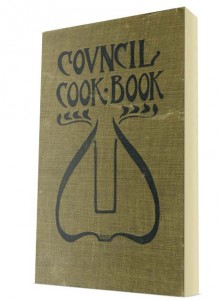Kosher Cookbooks: Retracing our History through Recipes
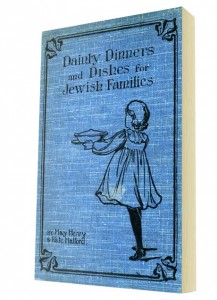
Published in London in 1907, this cookbook contains over 600 recipes and provides sample menus to assist the busy kosher housewife. Includes vintage ads, giving the cookbook a distinctly English flavor. Vintage cookbook images courtesy of Eli Genauer
By Naomi Ross
When Eli Genauer reads an old cookbook, it’s not for the recipes. Like a detective on the hunt, Genauer searches cover to cover for clues of a time long passed and for insights that can be gleaned from them. Advertisements for the Ice Delivery Company (for icebox use) or for the North Pacific Railway in The Neighborhood Cook Book (Portland, 1912) are the kinds of historical traces that interest him. A longtime collector of old Jewish sefarim, Genauer, who lives in Seattle, acquired his first cookbook in 2008 at an auction at Kestenbaum & Company, a New York City-based boutique auction house dedicated to the sale of rare books, manuscripts and Judaica. When the Yiddish cookbook Vegetarish-Dietisher Kokhbukh, 400 Shpayzn Gemakht Oysshislekh Fun Grinsn (Vegetarian-Dietetic Cookbook: 400 Meals Made Exclusively from Vegetables [Vilna, 1938]) came up, he was intrigued. “The pre-auction estimate was one hundred to one hundred and fifty dollars. It ended up selling for $3,245. It hardly ever happens that the pre-auction estimate is so far off. That sort of piqued my interest in this category,” says Genauer. What would make a cookbook so valuable—how special could the recipes be?
A rare relic out of pre-war Vilna, Vegetarish-Dietisher provides evidence of a new modern Jewish culture evolving on the eve of the destruction of the Jewish community in Lithuania. Fania Lewando, the cookbook’s author, owned a vegetarian restaurant popular amongst the avant-garde—it provided a progressive atmosphere where she could serve up her philosophy on vegetarianism
with generous helpings of mock kishke filled with mushrooms and breadcrumbs. She advocated growing your own food and using high-quality ingredients while teaching to make use of every last bit, without waste. Lewando was killed fleeing the Nazis after they invaded Vilna in 1941, and few copies of her cookbook remain.1 The menus and the ingredients used give a more complete picture of how people lived their everyday lives at the time. It is this kind of background history and context that piques Genauer’s curiosity.
Genauer chuckles as he points out some of the more subtle cultural elements evident in his collection. The compilers of Council Cook Book (San Francisco, 1909) were reputable German women and are referred to by their husbands’ names. “Mrs. David Hirschler wouldn’t have used her own name—it came out pre-suffrage.” The Ladies Auxiliary to Temple de Hirsch Famous Cook Book (Seattle, 1916) included home remedies and household tips like how to kill corns, remove iron rust and care for ivory handled knives. Notice these small details and an early snapshot of Jewish life in America emerges; trace our modern history through cookbooks and the connection between cooking and the Jewish experience will appear.
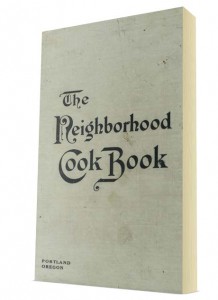
One of the earliest Jewish charity cookbooks, The Neighborhood Cook Book was sold out within ten months of its first printing (Portland, 1912).
PRE-1900: THE EARLY YEARS
Of his antique cookbook collection (about twenty-five books in all), almost all precede 1940. “This is for an auction taking place in Jerusalem,” explains Genauer, referring to Rebekka Wolf’s Kochbuch für Israelitische Frauen (Cookbook for Jewish Women [Berlin, 1851]), one of the most successful early Jewish cookbooks, which went through fourteen editions in several languages. Cookbooks like this one or The Jewish Manual or Practical Information in Jewish and Modern Cookery (London, 1846), the first Jewish cookbook written in the English language, appeared across Europe and served as common gifts for young brides, the aspiring Jewish bourgeois. Similarly, Esther Levy wrote the first Jewish cookbook in the United States, Jewish Cookery Book on Principles of Economy Adapted for Jewish Housekeepers with the Addition of Many Useful Medicinal Recipes and Other Valuable Information Relative to Housekeeping and Domestic Management (Philadelphia, 1871). These early personal cookbooks focused on training an upper class kosher housewife and assumed a certain amount of domestic help was available at home.
Trace our modern history through cookbooks and the connection between cooking and the Jewish experience will appear.
“Most of the first [Jewish-American cookbooks] were printed for the Reform German Jews who had done away with kashrut. They had money to spend and publish,” says Genauer. Aunt Babette’s (a pseudonym for Bertha Kramer), published by Edward H. Bloch (Cincinnati, 1889, with dozens of editions thereafter) offered lengthy instructions on gourmet cuisine and fashionable table setting, including non-kosher recipes, reflecting the Reform community from which it emerged. Indeed, Bloch’s brother-in-law was the head of the Reform movement, the predominate Jewish movement in America in the late 1800s. In 1880, most of the approximately 250,000 Jews in America identified with the Reform Movement—an easier avenue of worship for Jews of high social status and more synonymous with “proper” American religious experiences. As such, a sizeable number of the early Jewish cookbooks, especially community cookbooks, were not kosher.
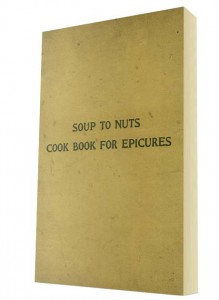
Published in 1931 during the Great Depression, Soup to Nuts served as a work project at a time when jobs were scarce. Each copy of this cookbook was constructed by hand—from typing to binding to decoration.
1900-1950: COOKBOOKS TO ACCLIMATE, COOKBOOKS TO ASSIMILATE
When the next wave of immigrants and refugees came to American shores in the early 1900s, community cookbooks proved an effective way of aiding them to acculturate and assimilate into the “New World.” This model fostered unity and raised financial support in one collaborative culinary swoop. Of the more than 700 Jewish cookbooks collected by Assistant Chief Librarian Roberta Saltzman at the New York Public Library’s Dorot Jewish Division, community cookbooks comprise the largest segment. At a 2013 exhibit on Jewish gastronomic literature, “American Foodways: The Jewish Contribution,” Jan Longone, founder of the University of Michigan Library’s fifteen-year-old Janice Bluestein Longone Culinary Archive, accomplished the daunting feat of acquiring Jewish charity cookbooks from synagogues and Jewish groups in every state.
Most famous, The “Settlement” Cookbook (Milwaukee, 1901) by Lizzie Black Kander, raised funds for recent Jewish immigrants in Milwaukee. Forty editions and nearly two million copies of The “Settlement” Cookbook sold, benefitting The Jewish Settlement House in Milwaukee, aiding immigrants’ assimilation into the American melting pot.
Published during the Great Depression, Soup to Nuts: Cook Book for Epicures (Emanu-El Sisterhood [San Francisco, 1932]) aimed at benefiting the unemployed. The introduction’s tattered, yellowed pages read: “Girls without work for long periods of time have been employed and paid (or others have volunteered) in the typing, stenciling, mimeographing, assembling and even decorating of this loose-leaf book.” While the Depression was crippling the nation, this cookbook served as a work project—each copy was hand-typed! At one of Genauer’s public lectures, where he spoke about his collection, an older woman in the crowd raised her hand and announced: “I was one of the typists!”
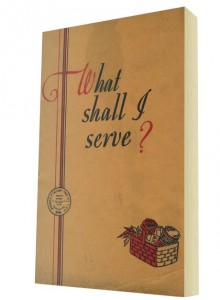
Published by the Rumford Company in 1931, the recipes in this cookbook all involve baking power, Rumford’s primary product.
In contrast to these secular publications, many cookbooks did cater to the needs of new religious immigrants. Despite his early success and his Reform leanings, Bloch recognized a business opportunity. He released several cookbooks to serve the huge influx of kosher immigrants. The International Jewish Cook Book: 1600 Recipes According to the Jewish Dietary Laws with the Rules for Kashering: The Favorite Recipes of America, Austria, Germany, Russia, France, Poland, Roumania, Etc., by Florence Kreisler Greenbaum (New York, 1919) included a chapter on Passover dishes with explicit explanations on “how to set the table for the service of the ‘Seder’ on the eve of Passover or Pesach.” Recipes (which bordered on loose directives) described how to make a “Pesach borscht,” a recipe requiring that one begin preparing it approximately three weeks prior to Pesach.
The Jewish Home Beautiful (National Women’s League of the United Synagogue of America, New York, 1941) was produced with the hope of inspiring Jewish ritual observance by emphasizing the beauty of the Jewish table and tradition (e.g., cheese blintzes dusted with ten lines of cinnamon to represent the Ten Commandments for a Shavuot table). While immigrants were trying to assimilate their first-generation American children into mainstream culture, the goal of this popular cookbook was to transmit Jewish religious practice from mother to daughter; by 1958, it had reached its ninth edition.
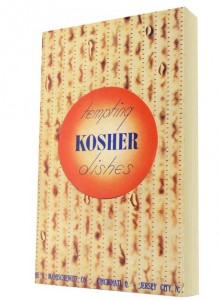
A Pesach cookbook published by Manischewitz in 1926, which, at the time, only produced matzah products. Like the Rokeach Cook Book and What Shall I Serve, Tempting Kosher Dishes was printed with one half English, one half Yiddish, to appeal to the new immigrant population (Cincinnati).
Appealing to the new immigrant population was beneficial to food manufacturers as well—both Jewish and non-Jewish alike. Early promotional kosher cookbooks were put out by kosher brands like Rokeach (Brooklyn, 1933), its book split in half: one side English, one side Yiddish.
Rumford Baking Powder reached out to the observant Jewish community in What Shall I Serve? Famous Recipes for Jewish Housewives (Rumford, 1931), offering traditional recipes that came “from a private search among Jewish mothers whose very joy in life is the preparation of Friday night’s supper for the family.” Apparently even then, mainstream manufacturers recognized the priority Jewish homes placed on home cooking and saw promise in demographic marketing.
1950-2000: PRESERVATION AND HISTORICAL COOKBOOKS
As Jews became further assimilated after World War II, the role of kosher cookbooks shifted towards maintaining culturally Jewish dishes. Waning religious observance created a desire to hang on to Jewish traditions through the foods that represented them; dishes like kugels, gefilte fish, and gribenes became iconic Jewish foods. The Art of Jewish Cooking by Jennie Grossinger (New York, 1958) and How to Cook Like a Jewish Mother by June Roth (New York, 1969) were both replete with Yiddishisms and heimishe flavor. In the latter, one chapter is lovingly entitled “Ess from the Cookie Jar: A Balabusta’s Bake-Off.” Kosher cookbooks sought to capture the flavor of Jewish life that tasted like home even as religious life was evaporating.
The 1980s and 1990s brought a shift to the style and purpose of kosher cookbooks, broadening them to become vehicles for teaching history and culture and preserving traditions. Claudia Roden’s James Beard Award winning The Book of Jewish Food: An Odyssey from Samarkand and Vilna to Present Day (New York, 1996), Joan Nathan’s Jewish Cooking in America (New York, 1994) and Gil Marks’ The World of Jewish Cooking: More Than 400 Delectable Recipes from Jewish Communities (New York, 1996) all brought history to the table, providing recipes, histories and perspectives on Jewish culinary traditions the world over. These cookbooks connected the dots between recipe and context, widening the definition of “Jewish” or “kosher” food.
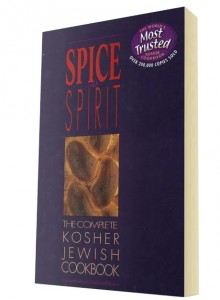
Known fondly as the “Purple Cookbook,” Spice and Spirit: The Complete Kosher Jewish Cookbook, published by Lubavitch, has become the go-to cookbook for many Jewish women for its easy-to-use recipes and interwoven notes on Jewish law, tradition and spirituality.
While these cookbooks captured the rich culture and backgrounds of the Jewish diaspora in the past, one cookbook took on the role of cultivating observant Jewish life for the future. In 1977, Lubavitch Women’s Organization: Junior Division published Spice and Spirit: The Complete Kosher Jewish Cookbook. Reprinted in 1990 by Lubavitch Women’s Cookbook Publications, Spice and Spirit, considered a classic, has sold more than 200,000 copies since its original appearance, according to the Chabad web site. The cookbook echoed the same warm loving-kindness shown toward every Jew that characterizes Chabad. Practical explanations and instructions for each holiday or mitzvah went hand in hand with a large anthology of simple recipes bound to aid any aspiring balabusta. The “Purple Cookbook” became the go-to for many kosher cooks.
2000 AND BEYOND: THE KOSHER REVOLUTION
The year 2000 signaled a jump to the next chapter of modern kosher cookbooks. A fundraising cookbook published by Livingston, New Jersey’s Joseph Kushner Hebrew Academy changed the way kosher home cooks were preparing their meals. The popularity of the The Kosher Palette (Livingston, 2000) marked a return to elegant fare, on par with the latest trends in non-kosher cuisine: gourmet ingredients, spices we never heard of and plenty of pretty pictures to make your mouth water. This book’s enormous success launched the career of its editor, Susie Fishbein, leading to her well-embraced Kosher By Design (Brooklyn, 2003) cookbook series. The visuals were a game changer—page after page of stunning, professionally-styled food wowed home cooks who until that point used books with very few pictures. Along came these enticingly modernized recipes—beautiful, elegant, trendy and proudly kosher. “Kosher” cooking was redefined.
Kosher cookbooks sought to capture the flavor of Jewish life that tasted like home even as religious life was evaporating.
With the explosive trend of glamorous creative cooking and eating and the rise of the celebrity chef, the Jewish cookbook industry has also boomed, the lion’s share being kosher. “The growth has been exponential,” agrees Shloime Eichler of Eichler’s Judaica, one of the largest sellers (and online sellers) of Jewish books and Judaica, based in Brooklyn. In the last fifteen years, Eichler’s cookbook section has grown from two or three shelves to fifteen shelves—a full aisle of cookbooks, and new ones are prominently displayed in the front of the store. While some are published by Jewish publishers, many are the product of mainstream publishers like HarperCollins, who have made it a priority to publish cookbooks using only kosher ingredients—an affirmation of the demand.
“With Food Network and the Internet, books have had to become so much more visual and so much prettier,” says cookbook author and pastry chef Paula Shoyer. “The audience has also changed—kosher [consumers] are much more aware of what the rest of the world is eating. Today, [those who keep kosher] really want to experience what everyone is eating—we just want it kosher. There is a sense of entitlement for that.” She attributes this to exposure, partly due to media, but also as an outgrowth of the ba’al teshuvah movement.
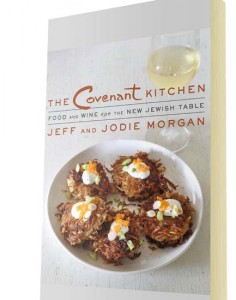
Published by OU Press in conjunction with Schocken Books, The Covenant Kitchen, a guide for the sophisticated kosher consumer, pairs recipes with the fine kosher wines of the Covenant Winery.
Unquestionably, we also have the OU to thank for this trend. The world’s largest and most respected kosher certification agency, the OU currently certifies 8,000 plants in more than eighty countries. “When we were growing up, super-sweet Malaga and Concord wines were the norm in Orthodox homes,” says Rabbi Menachem Genack, CEO, OU Kosher. “Over time, this has changed, and in the contemporary Orthodox world, a full range of fine kosher wine varietals are available for the kosher consumer. The extraordinary breadth of kosher products now available enables consumers to be more selective and discriminating in their food choices.” New cookbooks like the OU Press/Schocken Books’ The Covenant Kitchen: Food and Wine for the New Jewish Table (New York, 2015), which pairs recipes with the fine kosher wines of Covenant Winery, are catering to a more sophisticated and informed kosher consumer.
Classically trained in pastry arts in Europe, Shoyer found her niche in converting French dairy desserts into pareve versions. After editing two of Fishbein’s books, she wrote The Kosher Baker (Waltham, 2010) to fill a gap in the literature for kosher cooks. Her goal: classic European favorites updated and adapted for the kosher home.
With the explosive trend of glamorous creative cooking and eating and the rise of the celebrity chef, the Jewish cookbook industry has also boomed, the lion’s share being kosher.
“The focus used to be on Jewish or traditional foods—now it is more about the food that just happens to be kosher,” observes Genauer about how kosher cookbooks have changed today. “It also reflects the economics of the times—people today can afford more expensive ingredients.” Shoyer’s most recent book, The New Passover Menu (New York, 2015), surely makes use of many more ingredients than our grandmothers ever imagined. “We didn’t have hechshered almond or coconut milk ten years ago,” laughs Shoyer. With the help of kashrut organizations like the OU, “there is so much more to work with, and today’s cookbooks teach one how to use them.”
Despite dozens of new kosher cookbooks coming out each year though, there is a growing dependence on the Internet for recipes and kosher information. The proliferation of kosher blogs and kosher recipe database web sites like joyofkosher.com or gourmetkoshercooking.com has made the experience of kosher cooking larger, more interactive. People can find all the new ideas and recipes they need without relying on a physical cookbook . . . and all at the swipe of a finger. Is this the next chapter in the evolution of kosher cookbooks? Will we trade in our dog-eared, oil-stained pages for the sleek (and easy to wipe) tablet? Not likely, suspects Shoyer. “Jews love to try new things, especially finding new recipes.” And if within each cookbook is planted a hidden story about the evolution of Jewish life, then a garden of kosher cookbooks is still waiting to blossom.
Notes
1. The Vilna Vegetarian Cookbook: Garden-Fresh Recipes Rediscovered and Adapted for Today’s Kitchen(Schocken Books, 2015) is a modern adaptation, translated from the original Yiddish by Eve Jochnowitz, a teacher of Yiddish language and literature at the YIVO Institute for Jewish Culture and The Workmen’s Circle.
Naomi Ross is a cooking instructor and food writer. She teaches throughout the New York area and writes articles connecting cooking and Jewish inspiration. Her web site is www.koshercookingconcepts.com.

